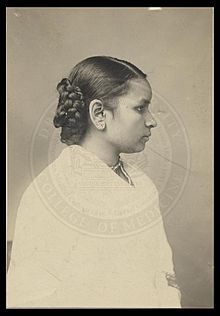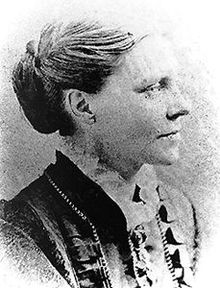The first facility in the world to train women for a medical degree was the Woman's Medical College of Pennsylvania, founded in 1850 in Philadelphia. The original name was the Female Medical College of Pennsylvania; the name change occurred in 1867. An associated hospital, the Woman's Hospital of Philadelphia, opened in 1861. The first graduating class, in 1851, consisted of eight students. A driving force behind the creation of the College was Bartholomew Fussell, a doctor whose daughter went on to become one America's first female scientists. Fussell's nephew Edwin and another doctor, Elwood Harvey, kept the school going when Bartholomew Fussell concentrated on other pursuits. Other supporters including the Society of Friends (Quakers) and the burgeoning feminist movement. Graduates of the women's medical college were not welcomed with open arms in much of America, however. The medical societies of both Philadelphia County and the State of Pennsylvania refused to admit female doctors for many years. In 1891, the women's college adopted a four-year curriculum. It was one of the first medical schools in America to do that. Among the famous alumnae of the College were Ananda Gopal Joshi, an Indian woman who took her degree back to India and practiced there; Susan La Flesche Picotte, the first female Native American doctor; Kazue Togasaki from Japan; and Jennie Kidd Trout, Canada's first licensed female doctor.
Togasaki had earned a bachelor's degree in zoology from Stanford University in 1920 and had studied nursing. She earned her medical degree from the Woman's Medical Degree in 1933. In the 1930s, however, she found it difficult to find work in the U.S. because of distrust of Japanese people. She herself was detained at a series of U.S. Government detention centers. She was released in 1943 and opened a medical practice in San Francisco. She specialized in delivering babies and, when she retired at 75, had delivered more than 10,000 children.
The college fell on hard times in the second half of the 20th Century, however. It admitted male students in 1969. (By this time, school organizers had dropped the word "woman's" from the name and the school was known as the Medical College of Pennsylvania.) A merger between the college and hospital and the Hahnemann Medical School occurred in 1993. Ten years later, the schools became part of the Drexel University College of Medicine. |
|
Social Studies for Kids
copyright 2002–2024
David White



 Joshi, in particular, is well known. The death of her newborn child spurred her to study medicine. Finding little opportunity to do so in India, she traveled to America and made her way to Pennsylvania and to the Medical College; she was able to make the trip, however, only because of financial backing of a concerned rich American. After two years of training, Joshi got her license. Sadly, she died of tuberculosis the following year, before being able to put her medical training into practice.
Joshi, in particular, is well known. The death of her newborn child spurred her to study medicine. Finding little opportunity to do so in India, she traveled to America and made her way to Pennsylvania and to the Medical College; she was able to make the trip, however, only because of financial backing of a concerned rich American. After two years of training, Joshi got her license. Sadly, she died of tuberculosis the following year, before being able to put her medical training into practice. Picotte was a member of the Omaha Tribe. A skilled healer, she studied many subjects and, through the financial backing of a concerned family friend, attended the Woman's Medical College, beginning in 1886. She graduated three years later, at the top of the class. Picotte returned to her tribe, on a reservation, and became famous in the surrounding area and throughout the country. She was a traveling doctor in addition to caring for the members of the reservation. She also became a prominent voice in the campaign to raise awareness about the dangers of tuberculosis and of the need for proper sanitation in medical facilities. Despite suffering from chronic pain, she maintained a rigorous schedule of caring for others. In the end, she died at age 50, at what later historians think was bone cancer. A hospital in Nebraska is named after her and is a National Historic Landmark.
Picotte was a member of the Omaha Tribe. A skilled healer, she studied many subjects and, through the financial backing of a concerned family friend, attended the Woman's Medical College, beginning in 1886. She graduated three years later, at the top of the class. Picotte returned to her tribe, on a reservation, and became famous in the surrounding area and throughout the country. She was a traveling doctor in addition to caring for the members of the reservation. She also became a prominent voice in the campaign to raise awareness about the dangers of tuberculosis and of the need for proper sanitation in medical facilities. Despite suffering from chronic pain, she maintained a rigorous schedule of caring for others. In the end, she died at age 50, at what later historians think was bone cancer. A hospital in Nebraska is named after her and is a National Historic Landmark. Trout was a teacher who was motivated by her own chronic illness to pursue a career in medicine. She studied medicine at the University of Toronto and then then Woman's Medical College, from which she graduated in 1875. She returned home and became her country's first licensed female physician. She opened her open institute, which was so successful that it opened branches in two other cities. She later helped form a medical school for women at Queen's University in Kingston, Ontario. She died in 1921; 70 years later, Canada Post honored her by showcasing her on the face of a postage stamp.
Trout was a teacher who was motivated by her own chronic illness to pursue a career in medicine. She studied medicine at the University of Toronto and then then Woman's Medical College, from which she graduated in 1875. She returned home and became her country's first licensed female physician. She opened her open institute, which was so successful that it opened branches in two other cities. She later helped form a medical school for women at Queen's University in Kingston, Ontario. She died in 1921; 70 years later, Canada Post honored her by showcasing her on the face of a postage stamp. The WMCP, as it became known, was so successful that it continued training women well into the 20th Century. A new campus that combined medical training and a hospital in one facility appeared in the 1920s.
The WMCP, as it became known, was so successful that it continued training women well into the 20th Century. A new campus that combined medical training and a hospital in one facility appeared in the 1920s. 
